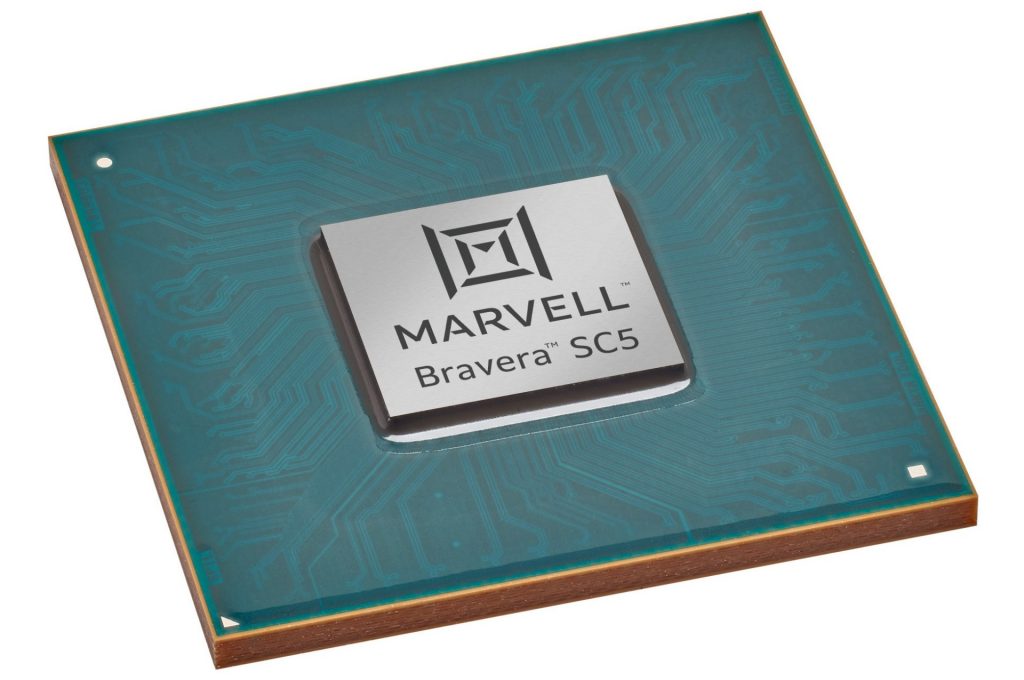The first enterprise SSD controller with PCI Express 5.0 support introduced
It looks like PCI Express 5.0 SSDs will roll out at slower pace than PCI Express 4.0 ones, but the first controller to use this technology is already coming. Marvell has now unveiled the Bravera SC5 chips, which are to power NVMe modules with read speeds of up to 14 GB/s and 2 million IOPS. To handle this, the chips have ten different ARM cores inside. These SSDs will likely only target servers for now though, not desktops or laptops yet.
PCI Express 4.0 SSDs have already become quite popular on the market, and it can actually be said that PCs are now probably the main justification or source of usefulness for this new generation of PCI Express. The highest performing NVMe modules with Phison E18 already more or less take full advantage of the bandwidth of PCI Express 4.0 ×4. However, PCI Express 5.0, which would open up additional potential for them, does not seem to be arriving anytime soon for SSDs. Ryzen 7000 “Raphael” processors for the AM5 socket are to only support PCI Express 4.0. And while Intel Alder Lake on the Z690 platform will already support PCI Express 5.0 ×16 for graphics cards, it is still only going to provide PCIe 4.0 ×4 slots for SSDs.
Because of this we’d thought that manufacturers of PCI Express 5.0 SSDs would not push them on the market as aggressively as with PCIe 4.0. Nevertheless, a controller using PCI Express 5.0 has now been revealed. During Computex 2021, Marvell announced the Bravera SC5 series chips that implement PCI Express 5.0. They will be designed primarily for servers, where PCI Express 5.0 will be deployed on a larger scale, but they could also be used on the Sapphire Rapids-X high-end processor platform and on future Threadripers with Zen 4 architecture.
Bravera SC5
Marvell Bravera will be a series of controllers for storage, not only for SSD, but also for HDD. It should include other more exotic storage technologies. However, Bravera SC5 controllers are focused only on NVMe SSDs.
Marvell introduced two versions: the Bravera SC5 MV-SS1331 is an 8-channel controller and the Bravera SC5 MV-SS1333 is a 16-channel controller, supporting twice as much parallelism in the connection of NAND chips, which naturally allows for higher performance. TLC, QLC, but also MLC and SLC type NAND Flash memory are supported. It is possible to use either DDR4-3200 (even with ECC, the interface has a width of 72 bits) or the more energy-efficient LPDDR4X-4266 as a cache.
Both controllers use PCI Express 5.0 ×4, so they keep the quad-lane width. Optionally, they can also use the dual-port function, where the interface is divided into two independent ×2/×2 ones.
The maximum read speed specified for 128KB blocks is 14 GB/s, maximum write up to 9 GB/s. During reads, the controller will be able to almost fully utilize the bandwidth of PCIe 5.0 (the missing rest is probably roughly corresponds to the overhead, judging by what the PCIe 3.0 and 4.0 ×4 disks are capable of). In random access, the controller should handle up to 2,000,000 IOPS during read and up to 1,000,000 IOPS during write—this is for 4KB blocks. Marvell reports the same performance for both variants, but one would expect that in practice, SSDs with the octa-channel controller may have lower performance.
10 ARM cores
According to Marvell, the controller is equipped with up to 10 ARM cores, which perform various tasks within the firmware and disk servicing—it is a combination of Cortex-R8 and M7 cores, plus one Cortex-M3 core used for encryption. However, for better energy efficiency, blocks with a fixed function have been added, which are speicalized for specific tasks. The power consumption of the controllers is 8.7 W for the 8-channel and 9.8 W for the 16-channel model, to which you would then have to add the consumption of NAND and DRAM cache. The final SSDs could have a maximum power consumption of about 15 W, if not higher, which is not abnormal for high-performance server storage.
Samples of these controllers already exist, Marvell already supplies them to enterprise SSD manufacturers. The launch of the modules will clearly take some time – after all, server processors with PCIe 5.0 are not coming for another three quarters of a year or so from now (at the earliest). But some prototype versions probably already exist, Marvell shows a sample server SSD, which has an “oversized” format larger than the M.2 module.
However, an SSD with Marvel Bravera SC5 might also be able to fit on a classic desktop M.2 form factor module (using packages with several layered NAND Flash silicone pieces). The controller has a package with the dimensions of 20 × 20 mm, maybe designed with such a use in mind, because 20 mm is the width of a standard M.2 module. This does not mean that such SSDs will be available to buy for PC, but some special types could exist (which could require more effort to find a source to buy from if you wanted one than usual client market SSDs).
Translated, original text by:
Jan Olšan, editor for Cnews.cz
